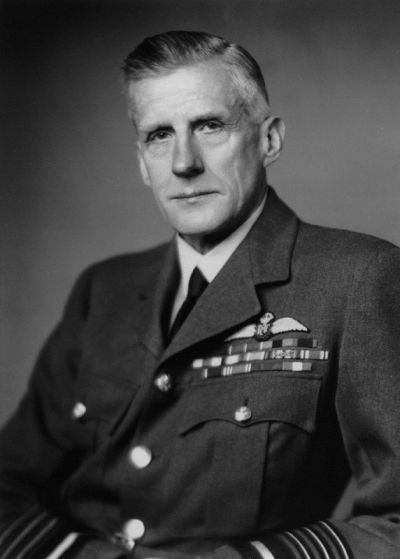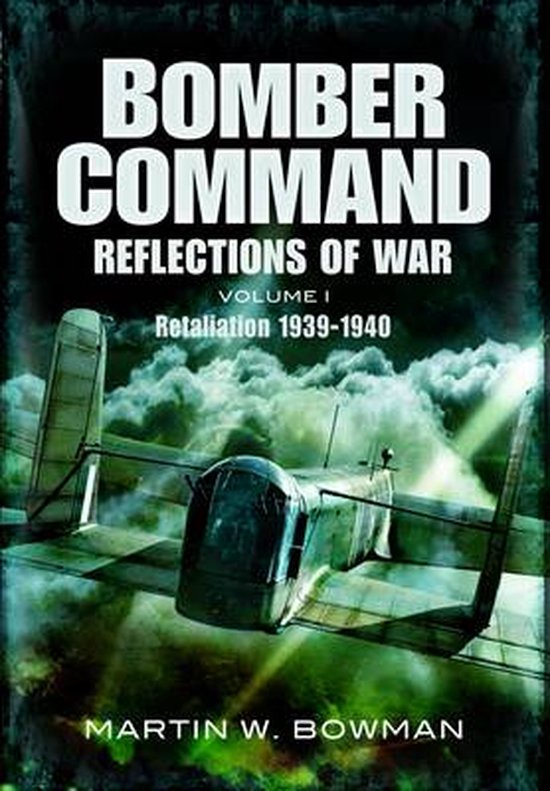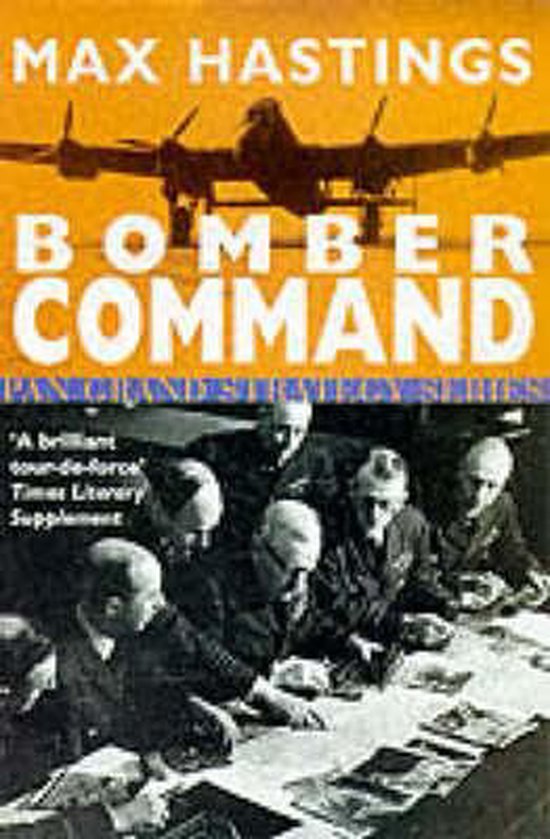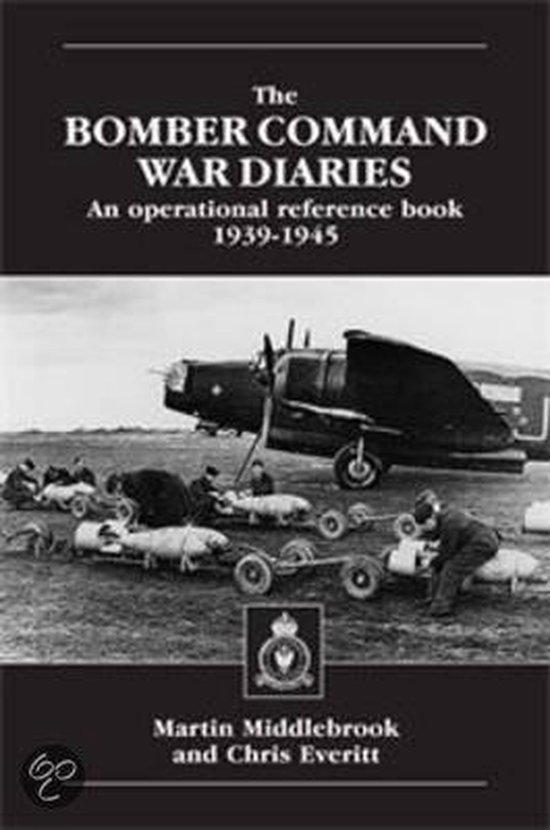Inleiding
At the outbreak of the Second World War RAF Bomber Command was composed of five Groups. The Command had four types of bomber aircraft at its disposal with which, , the whole of Germany could be reached, with the exception of the extreme eastern part of the country. Yet the role of the bomber fleet remained limited during the first year of the war. On the one side this was due to the directives with which Bomber Command had to comply. One of them was the fact that no ground targets were to be attacked. But also the antiquated bombers and the strategies rendered out of date had a large influence on the efficiency. During the first months of the war Bomber Command had to swallow some tough lessons. The most famous of those is the attack on the German Navy at Wilhelmshaven on 18 December, 1939. With a loss rate of more than 50 per cent this mission became the immediate reason for a change of strategy.
Definitielijst
- Bomber Command
- RAF unit which controlled strategic and sometimes tactical bombing (as in Normandy)
- RAF
- Royal Air Force. British air force
- strategy
- Art of warfare, the way in which war should be conducted in general.
Images
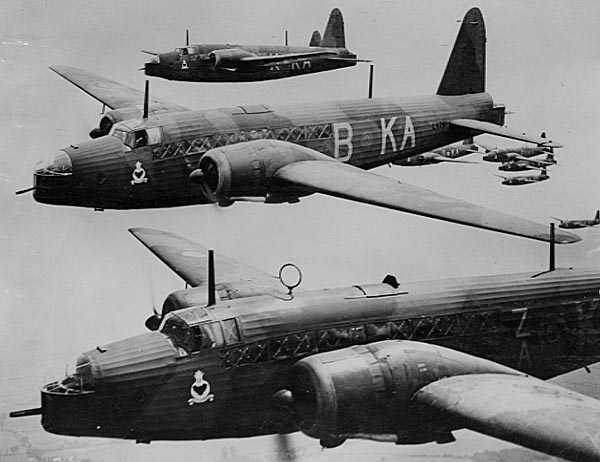 Wellingtons of No.9 Squadron flying in formation. Source: Royal Air Force.
Wellingtons of No.9 Squadron flying in formation. Source: Royal Air Force.Target Wilhelmshaven
Western Air Plans
Already in 1936 plans had been developed for the part Bomber Command would play in case of a German invasion of the west. These "Western Air Plans", sixteen in total, started from different presumptions (for example air raids on the UK or ground troops’ attacks on France) and the targets of Bomber Command were adapted for those. Air support for Poland however was not included in the "Western Air Plans" as this country was out of range for the British bombers. When the German armies advanced towards the east after the outbreak of the Second World War on 1 September, 1939 the role of Bomber Command was limited. This also had to do with an appeal by the American President Franklin Roosevelt. On the 1st of September, 1939, he had pressed the point with the war mongering countries to not carry out any air raids on non-defended cities or other targets which would cost the lives of civilians. Great Britain and France agreed immediately with this request and also Germany indicated on 18 September to comply with Roosevelt’s demand. As it appeared to be complicated to distinguish purely military targets from civilian targets the Air Ministry decided not to bomb any target on German soil. Western Air Plan 7B could be carried out within these limitations. This was the detailed planning for bombing of the German fleet in or near their base Wilhelmshaven in north west Germany at the North Sea coast. The surrounding water decreased the risk to make civilian German victims.
At this moment of the war it was assumed that bomber aircraft were able to defend themselves against attacking enemy fighter airplanes, even during daylight operations. Formations operated therefor without escorts, which would become a custom during a later stage of the war. During the first confrontations of the, still young, war the German fighter pilots however had discovered quickly the weak spots of the antiquated British bombers. They had found out that the Wellingtons could not defend themselves against attacks from the side. The gun turrets in the nose and tail could not turn far enough. Also the bombers were not yet equipped with self-sealing fuel tanks. Whenever a Wellington was hit there she could turn into a fireball within seconds or loose so much fuel that the home base got out of range. All this made the British bombers into an extremely vulnerable target. In spite of all that during the first two months of the war no great losses were made. On 14 December, 1939, five of fourteen Wellingtons had been downed during a reconnaissance attack north of Wilhelmshaven, but the RAF blamed these losses on anti-aircraft fire.
Target Wilhelmshaven
Shortly after this attack on 14 December, headquarters of 3 Group was planning already a new mission to Wilhelmshaven. The order said: "to attack enemy warships in the Schillig Roads or Wilhelmshaven. Great care is to be taken that no bombs fall on shore, and no merchant ships are to be attacked. Formations shall not loiter in the target area." In his headquarters, the afternoon of the 17th of December, Air Vice Marshall Sir Jack Baldwin called together all commanders of the squadrons involved in the attack. He briefed them personally about the mission. So the attack had to be carried out from 13,000 ft in order to stay out of effective reach of the German anti-aircraft guns, which were supposed to have caused heavy casualties a few days before. Later that same afternoon the message reached the squadrons that the crews needed to be ready from 07:30 the next morning. The formation of 24 aircraft was composed of the following:
9 Wellingtons of No.149 squadron (RAF Mildenhall, Suffolk)
Operated by the crews of Wing Commander Kellett, Pilot Officer Turner, Pilot Officer Speirs, Flight Sergeant Kelly, Flight Lieutenant Duguid, Flying Officer Riddlesworth, Sergeant Harris, Flying Officer Briden and Flying Officer Bolloch.
9 Wellingtons of No.9 Squadron (RAF Honington, Suffolk)
Operated by the crews of Squadron Leader Guthrie, Sergeant Petts, Flying Officer McRea, Flying Officer Challes, Flying Officer Allison, Pilot Officer Lines, Sergeant Ramshaw, Flight Lieutenant Grant and Sergeant Purdy.
6 Wellingtons of No.37 Squadron (RAF Feltwell, Norfolk)
Operated by the crews of Squadron Leader Hue-Williams, Flying Officer Lemon, Flying Officer Wimberley, Flying Officer Lewis, Flying Officer Thompson and Sergeant Ruse.
In the morning of 18 December, before sunrise, a Whitley of 78 Squadron took off from RAF Dishforth in Yorkshire. The aircraft crossed the North Sea in the direction of Helgoland. Arriving at 08:00 the sky was half cast over, which would provide the bombers the required coverage. A message was sent to headquarters of Group 3. The message was forwarded to the squadrons. Take off was to take place at 09:30. Over King’s Lynn in Norfolk the 24 Wellingtons were to assemble in formation.
At No. 9 and No. 149 Squadron the crews had been briefed the evening before about the planned mission. They were told that they might spot the German fleet in the Bight of Helgoland. Thereafter they were sent off to sleep. At No. 37 Squadron many men were told only just before take-off that they were nominated for this mission. Leading Aircraftman Harry Jones arrived by bicycle at RAF Feltwell, parked his bike and walked over towards the hangar when he was told that he had been assigned to be the tail gunner in the crew of Sergeant Ruse. He quickly changed clothes and without seeing any of the other crew members he took his seat in his gun turret. The aircraft started to move. Through the intercom he asked his pilot where they were heading. Ruse answered: "They’ve found the German Navy, and we’re going to Wilhelmshaven to attack them."
Definitielijst
- Bomber Command
- RAF unit which controlled strategic and sometimes tactical bombing (as in Normandy)
- invasion
- Armed incursion.
- RAF
- Royal Air Force. British air force
- Squadron
- A military unit in the Belgian navy usually six to eight small ships operating together under one command. The smallest military unit in the Dutch air force of about 350 men. In most countries is the designation of a military unit thesize of a company. It is either an independent unit, such as a battery, or part of a bigger Calvary unit. In the air force it is the designation of a unit of aircrafts.
Images
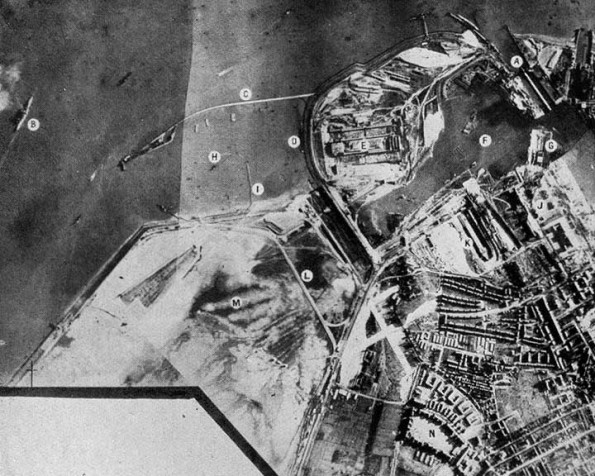 RAF reconnaissance photograph of the German naval base at Wilhelmshaven. Source: Royal Air Force.
RAF reconnaissance photograph of the German naval base at Wilhelmshaven. Source: Royal Air Force.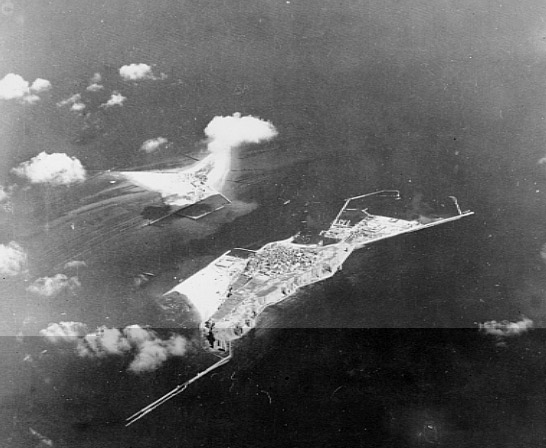 RAF reconnaissance photograph of the Bight of Helgoland. Source: Royal Air Force.
RAF reconnaissance photograph of the Bight of Helgoland. Source: Royal Air Force.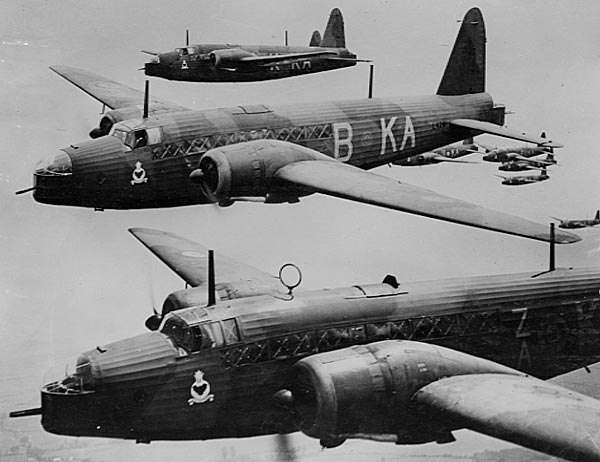 Wellingtons of No.9 Squadron flying in formation. Source: Royal Air Force.
Wellingtons of No.9 Squadron flying in formation. Source: Royal Air Force.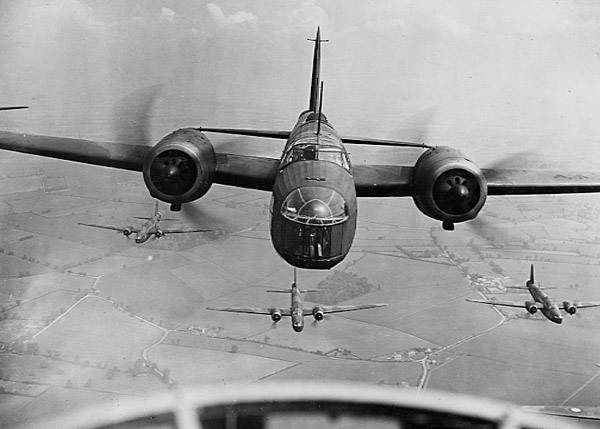 Wellingtons of No.9 Squadron flying in formation. Source: Royal Air Force.
Wellingtons of No.9 Squadron flying in formation. Source: Royal Air Force.The attack
The 24 bombers flew in 4 sections of six aircraft each. Every section of six flew in a double V-formation of three each. The aircraft in the lead was flown by 34 year old commander of No. 149 Squadron, Wing Commander Richard Kellett. Squadron Leaders Guthrie and Hue-Williams on their turn commanded the bombers of their own squadrons (No.9 and No. 37 Squadron). The pilots were prohibited to have radio contact. The only way of communication was by means of signal lamps. This caused a misunderstanding after some two hours. Flight Lieutenant Duguid, leader of the second V-formation, ran into engine trouble. It appeared not to be possible any longer to keep up with Kellett and his Wellington had to turn around. This message was transmitted to his two flanking aircraft. One of them missed the transmission and the pilot of this airplane, Sergeant Kelly, followed Duguid and returned also to RAF Mildenhall, where they landed at 13:30.
As a consequence of this misunderstanding 22 aircraft were left for the attack. They flew over the North Sea where the sky was indeed partly overcast. However, at a distance of some 90 kilometers from their target there was a clear blue sky. The bombers were clearly visible for German fighter planes. An attack did not occur however, in spite of the fact that the Germans had spotted the approaching formation already by means of their Freya radar system. At the local Luftwaffe headquarters in Jever, west of Wilhelmshaven, they could not believe that the British would attack during these weather circumstances. Therefore in first instance they had thought about a mistake of their recently developed radar system when the air fleet was reconnoitered. Only after reports from German naval air spotters a fighter squadron was alerted. Right at the moment the first Messerschmidts were seen, the German anti-aircraft batteries opened fire at the British bombers. These were at such altitude however that they were out of range of the grenades. Still the anti-aircraft guns sorted the effect that the bombers did not maintain their strict formation when they arrived over their target area.
Flying over Wilhelmshaven Wing Commander Kellett saw some ships below him. To his opinion they were too close to the quays and, following his orders he did not want to run the risk that bombs would fall on the German mainland. Therefore the aircraft changed heading to the west and flew back in the direction of England. The German fighters now took their chances as yet. They attacked the first four aircraft. At the first shots of an Me110 immediately the Wellington of Pilot Officer Speirs was hit. An explosion followed and the aircraft caught fire. Whining it turned away and downwards out of the formation in order to plunge into the sea which none of the crew survived. A new attack followed, this time by an Me109. The guns of the three remaining aircraft however succeeded in downing the fighter plane. The German pilot used his parachute but would drown because of his heavy outfit. The three Wellingtons of Kellett, Turner and Riddlesworth succeeded to escape from further attacks.
Behind them the loose formation also suffered from the necessary attacks. The two Vs on the left hand side (Guthrie, Pett, McRea, Challes, Allison and Lines) were beaten apart by the German fighters. The Wellington of Guthrie was shot ablaze and plunged into the sea. The N2939 of Flying Officer Challes received a full hit in the middle of her fuselage and broke in two. Also the aircraft of Flying Officer Allison was hit. She floated to the direction of the water with one engine on fire. The crews of all three bombers lost their lives. Sergeant Pett succeeded in returning his heavily damaged aircraft to England, and made an emergency landing in Sutton Bridge in Lincolnshire. The Canadian Sergeant McRea made an emergency landing at RAF North Coates, also in Lincolnshire. The fate of the also not returned crew of Pilot Officer Lines is unknown.
Also the right hand sections of the formation (Harris, Briden, Bolloch, Ramshaw, Grant and Purdy) were attacked by German fighters. These aircraft however had stayed much closer together and therefore could much better defend themselves. The German fighter aircraft succeeded in hitting the bombers several times, which killed the gunner of Ramshaw. The other gunners succeeded in downing two aircraft and beat the attack. The Wellington of Flying Officer Briden had been hit so severely that he could not reach England anymore. In front of the English coast a successful emergency landing was made. The rough and cold sea however was responsible for the fact that two of the crew drowned. The crews of the two shot down German aircraft survived.
Five Wellingtons of No.37 Squadron (Hue-Williams, Wimberley, Lewis, Thompson and Ruse) flew in the rear and were therefore the easiest target. They were attacked by German Fighter planes under the command of Leutnant Helmut Lent. Flying Officers Wimberley and Lewis tried to escape by turning into a steep dive, but were shot down by Lent himself and crashed near the island of Borkum. Eight of the ten flight crew did not survive the crashes. Sergeant Ruse succeeded in making an emergency landing on the same island, but two of his crew had already been killed in the air by German fire. The Wellingtons of Squadron Leader Hue-Williams and Flying Officer Thompson have most likely also crashed into the sea as they have never returned. The original section of 37 Squadron consisted of six aircraft. The Wellington of Sergeant Lemon had left the formation already before they reached the target area. At trying to open the bomb hatches the co-pilot had erroneously used the wrong handle and put down the flaps. After the aircraft turned sharply upwards, it ended immediately afterwards in a steep nosedive. Lemon succeeded just in time to regain control of the Wellington and skimmed just over the water surface. Almost immediately an attack by two Me109s followed. The German fighters succeeded in the first run to damage the aircraft. At the moment they approached again, the tail gunner suddenly cried: "Christ! He’s gone straight in!". The front Me109 hit the water with its wingtip and crashed into the sea. The other fighter plane broke off the attack. A few hours later the Wellington returned on RAF Feltwell. Here it appeared to be the only Wellington of Squadron 37 that had survived the raid.
Definitielijst
- Freya
- German long range radar named after a Germanic goddess. Was used as an early warning system for incoming bombers. Could detect aircraft from take-off.
- Luftwaffe
- German air force.
- radar
- English abbreviation meaning: Radio Detection And Ranging. System to detect the presence, distance, speed and direction of an object, such as ships and airplanes, using electromagnetic waves.
- RAF
- Royal Air Force. British air force
- raid
- Fast military raid in enemy territory
- Squadron
- A military unit in the Belgian navy usually six to eight small ships operating together under one command. The smallest military unit in the Dutch air force of about 350 men. In most countries is the designation of a military unit thesize of a company. It is either an independent unit, such as a battery, or part of a bigger Calvary unit. In the air force it is the designation of a unit of aircrafts.
Images
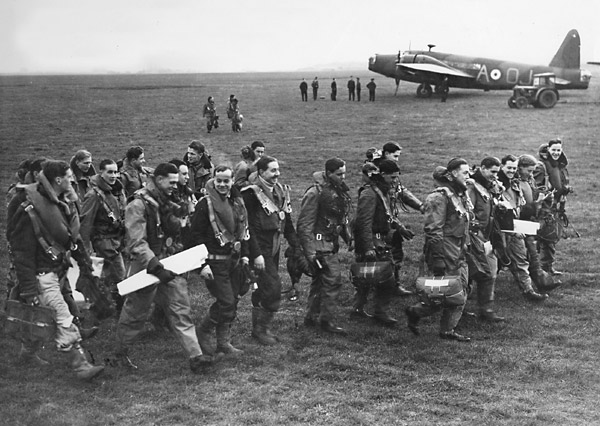 Crews of No.149 Squadron. Source: Royal Air Force.
Crews of No.149 Squadron. Source: Royal Air Force.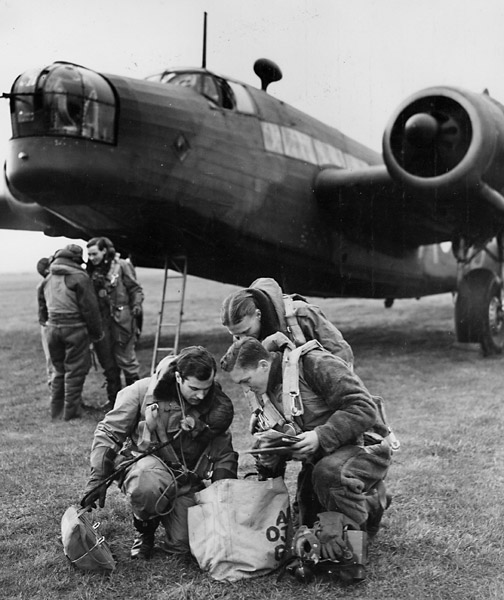 Flight crews of 149 Squadron checking their equipment. Source: Royal Air Force.
Flight crews of 149 Squadron checking their equipment. Source: Royal Air Force.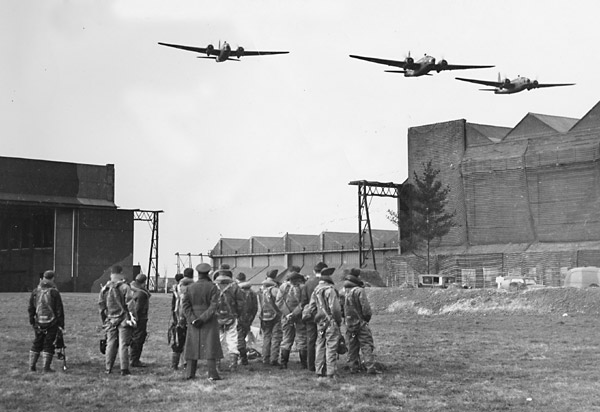 Wellingtons of No.149 Squadron in take-off from RAF Mildenhall. Source: Royal Air Force.
Wellingtons of No.149 Squadron in take-off from RAF Mildenhall. Source: Royal Air Force.Change of tactics
Within four days, half of all 34 Wellingtons which had participated on missions to Wilhelmshaven had been lost. In the attack of 18 December also 56 aircrew had been killed and five had been made prisoner. One of those prisoners, Aircraftman 1st Class Geddes died during his imprisonment of the wounds he had received during the emergency landing of his Wellington. Apart from that, both attacks had not had any result worth mentioning. Not a single German war ship had been sunk and the losses on German side (2 killed pilots) were in no proportion compared to the British losses.
In his report about this operation Air Vice Marshall Sir Jack Baldwin placed the reason for the high number of losses with the Squadron Leaders Guthrie and Hue-Williams. They were supposed to have shown a lack of leadership and to have been responsible for the falling apart of the close formation which left the bombers all by themselves. Air Chief Marshall Sir Edgar Ludlow-Hewitt, the Commander in Chief of Bomber Command, in first instance adhered to this report but blamed the acting by the Squadron Leaders to a lack of training and fighting experience. In the weeks after 18 December 1939, Ludlow-Hewitt also agreed that the old line of thought, that bombers could defend themselves in daylight flights effectively against enemy fighters, was simply outdated. The Wellingtons but also the Hampdens and Whitleys were too slow and vulnerable and thus sitting ducks for the much more modern fighters of the Luftwaffe. They required the protection of darkness to comply with their tasks. Flights that had to take place during daylight, like reconnaissance flights, from now on would be more and more often carried out by the Bristol Blenheim, which limited the losses by daylight. Next to this change of strategy the disastrously ending of the attack on 18 December also became the reason for another decision. After this mission the Wellington bombers would be sooner equipped with extra armor and self-sealing fuel tanks.
In spite of the heavy losses during the reconnaissance missions for the German naval ships, headquarters of Bomber Command for the time being stuck to the rule to only attack German targets at sea and not to carry out operations against targets on shore, other than the dropping of propaganda leaflets. Only three months later this was abandoned after on March 16th, 1940, German bombs had been dropped on the English village of Bridge of Wraight and a British citizen was killed. This was the reason for the bombing of airbase Hörnum.
Definitielijst
- Bomber Command
- RAF unit which controlled strategic and sometimes tactical bombing (as in Normandy)
- Luftwaffe
- German air force.
- propaganda
- Often misleading information used to gain support among supporters or to gain support. Often used to accomplish ideas and political goals.
- Squadron
- A military unit in the Belgian navy usually six to eight small ships operating together under one command. The smallest military unit in the Dutch air force of about 350 men. In most countries is the designation of a military unit thesize of a company. It is either an independent unit, such as a battery, or part of a bigger Calvary unit. In the air force it is the designation of a unit of aircrafts.
- strategy
- Art of warfare, the way in which war should be conducted in general.
Images
Information
- Article by:
- Pieter Schlebaum
- Translated by:
- Fred Bolle
- Published on:
- 19-04-2014
- Last edit on:
- 30-09-2024
- Feedback?
- Send it!
Related books
Sources
- BOWMAN, M., Bomber Command Reflections of War, Volume 1, Pen & Sword Books, Londen, 2012.
- BOWYER, C., History of the RAF, The Hamlyn Publishing Group Limited, Londen, 1979.
- CHORLEY, W., Bomber Command Losses of the Second World War, Midland Publising, Sittingbourne, 1998.
- MAX HASTINGS, Bomber Command, Pan Macmillan, London, 1999.
- MIDDLEBROOK, M. & EVERITT, C., The Bomber Command War Diaries, Midland Publishing, 2011.
37 Squadron Operations Record Book December 1939
149 Squadron Operations Record Book December 1939
